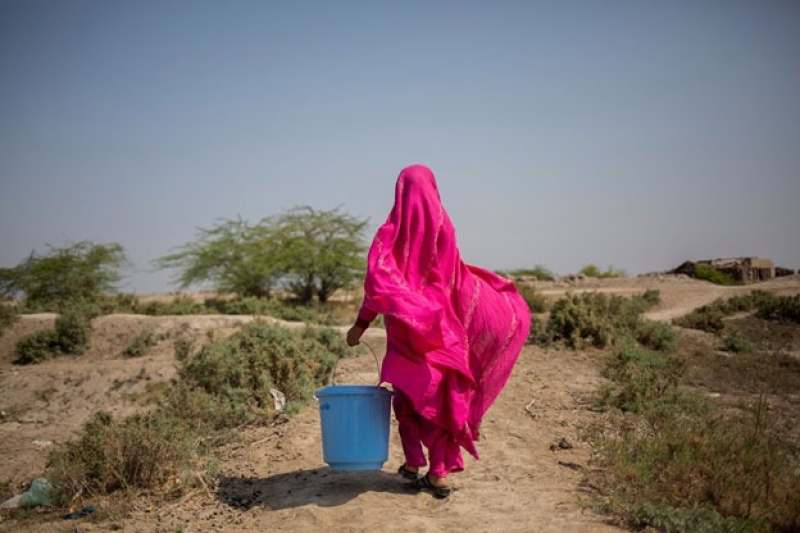- Hasina Sentenced to Death Over Crimes Against Humanity |
- Gaza Begins Mass Cleanup to Restore Dignity and Normal Life |
- BNP weighing review of some nominations amid grassroots unrest |
- US presses for Gaza resolution as Russia offers rival proposal |
- 35 crude bombs, bomb-making materials found in Geneva Camp |
Extreme Heat Threatens Asia-Pacific: Urgent Action Needed

A girl walking to collect water for her family in Sindh Province, Pakistan. Heatwave posed social impact on vulnerable groups such as women and girls.
The year 2024 was the hottest on record globally. In Asia and the Pacific, Bangladesh was the worst-hit country, with about 33 million people affected by lower crop yields that destabilised food systems, along with extensive school closures and numerous cases of heatstroke and related diseases. Children, the elderly and outdoor low-wage earners in poor and densely populated urban areas suffered the most, as they generally had less access to cooling systems, water supplies or adequate healthcare. India, too, was severely affected, with around 700 heat-related deaths, mostly in informal settlements.
Higher-income areas usually lie in cooler, greener neighbourhoods, so the hottest districts are often the poorest — deepening social inequality. In the city of Bandung, Indonesia, for example, a study shows temperature differences of up to 7°C between the hottest and coolest parts of town.
Future prospects for the region will depend critically on the trajectory of climate change. Under a high-emissions scenario, extreme heat is projected to become more frequent, intense and widespread — events that were once occasional could become seasonal or even year-round. Rising temperatures will also affect other parts of the Earth’s ecosystem, notably through accelerated glacial melt.
Warming in the Arctic can influence weather, precipitation and glacial behaviour across Central and South Asia. Globally, glaciers have already lost about 5 per cent of their volume this century. By 2060, under a high-emissions scenario, the Islamic Republic of Iran, Mongolia, Myanmar, Türkiye and Uzbekistan could lose more than 70 per cent of their glacier mass. These changes will also contribute to sea-level rise, raising existential risks for several Pacific nations.
To address these challenges, countries will meet this week at the United Nations Economic and Social Commission for Asia and the Pacific to consider opportunities to integrate heat risk into early warning systems and development planning.
The key priority is to shift from reactive heat-risk management to long-term, science-informed strategies. Policy actions are needed at local, national, regional and global levels. This being the International Year of Glacial Preservation offers a critical opportunity for collective action.
At the local level, nature-based solutions such as tree-lined streets, urban parks, green roofs and wetland conservation help lower urban temperatures. These measures increase shade, promote evapotranspiration and act as heat sinks, reducing urban heat island effects. Vegetation and tree canopies can reduce peak summer temperatures by up to 5°C. In Singapore, for example, green roofs and walls have been shown to lower surface temperatures by up to 17°C and ambient air temperatures by as much as 5°C.
Countries in Asia and the Pacific can significantly reduce heat-related illness, mortality and livelihood disruptions by building heat-ready, multi-hazard early warning systems. Expanding heat-health warning systems in just 57 countries could save approximately 100,000 lives each year.
To support countries, ESCAP plans to scale up climate-responsive and inclusive social protection schemes that include technical support for heat-specific provisions ensuring readiness, along with income and non-income assistance, especially for the poor in densely populated urban areas.
Recognising the benefits of nature-based solutions, ESCAP can also help strengthen collaboration among national governments, municipalities and local communities to create green, cooling cross-border corridors. These passages can lower temperatures, reduce surface heat and provide buffers against desertification, land degradation, drought, and sand and dust storms.
Finally, the region must accelerate the use of innovative space-based solutions to strengthen heat preparedness within early warning systems. Despite their proven benefits, coverage remains incomplete. Only 54 per cent of global meteorological services issue warnings for extreme temperatures, and even fewer provide alerts for heatwaves or thermal stress. In Nepal, for instance, a community survey revealed that about three-quarters of respondents from vulnerable groups had not received any heat alerts.
ESCAP can leverage existing cooperation frameworks to share Earth-observation data and technical expertise for mapping and monitoring heat exposure and urban vulnerability. This information enables more precise forecasting, better quantification of heat risk and the timely issuance of alerts.
The Asia-Pacific region has considerable experience managing cascading disasters, but the rising threat of extreme heat adds new urgency. Every country must act now to meet the scale of this evolving disaster-risk landscape and to accelerate regional cooperation. ESCAP stands ready to support countries in these endeavours as the world prepares for an ever-hotter future.

